dApp Security Challenges: How to Protect Your Users

Table of Contents
The global blockchain market was valued at $17.46 billion in 2023 and is projected to grow at a staggering CAGR of 87.7% from 2023 to 2030.
In just 15 years, blockchain has undergone a security transformation like no other.
However, as decentralized networks scale to accommodate more users and transactions, complexity generates vulnerability.
Weak points are exposed, and they make systems more susceptible to attacks.
In today’s article, we will explore the security challenges that dApps face and the measures you can take to protect your assets.
Let’s dive in!
Common Security Challenges in dApps

Without further ado, let’s unpack the common security challenges in dApps.
Phishing and Frontend Attacks
Today, phishing and frontend attacks are major risks for decentralized apps.
In phishing attacks what happens is that the hackers create fake websites that look like real dApps. So, when users connect their wallets, attackers are able to steal their assets. A simple mistake can lead to permanent loss.
Frontend attacks happen when hackers tamper with the dApp’s interface. They might change transaction details or redirect funds to their own wallets. Even if the smart contract is safe, a hacked frontend can trick users into approving harmful actions.
Private Key and Wallet Breaches
Just like a thief can be a threat to your home, a hacker is a threat to your crypto wallet. That’s why you must be excessively careful with your private key and wallet.
If someone gets access to it, they can steal all your assets. Hackers often target users through phishing scams, malware, or weak security practices to obtain private keys.
Wallet breaches can happen if the wallet software has vulnerabilities or if users store keys unsafely.
Once a private key is stolen, there’s no way to recover lost funds.
Data Storage and Centralized Network
Even though DApp frameworks have evolved, many still rely on centralized data storage for certain functions, like storing user data or off-chain information. This creates a weak point because centralized storage is susceptible to hacks and breaches.
Even if the decentralized part of the DApp is secure, the connection to cloud servers or databases can still be exploited. Hackers can target these storage points and reveal sensitive information.
This hybrid structure undermines full decentralization and can leave your data at risk.
Human Error
Even if the dApp is highly secure, we are all part of the systems and as humans, we still make mistakes. It is possible to accidentally expose sensitive information by losing devices or falling for scams.
For instance, let’s assume that one day you plan to work in a coffee shop. Just to place your order you step away while leaving your laptop unlocked.
If someone steals it or accesses your connected dApp, they could approve transactions or steal sensitive data. Even with decentralized security, physical access to a device can compromise the network.
Deceitfully Designed dApps
Some decentralized apps may look real and trustworthy, but they are actually designed to trick users. These dApps are made with the sole intention of wanting to steal your information or funds.
They pretend to be legitimate, but behind the scenes, they are intentionally compromised. Once you engage with these dApps, the attackers can gain unauthorized access to wallets or personal data, which then leads to the loss of funds. It’s like a fake shop or online scam.
Strategies to Protect Users From dApp Security Challenges

Scams and security challenges have always been a part of our lives because the human race is a mix of both good and bad. But thanks to technology, staying vigilant is now easy. You can protect yourself from hackers and scams with a few strategies. Take a look!
Smart Contract Audits
One of the most important steps today is a smart contract audit. It’s a professional review of the code to make sure there are no susceptibilities or mistakes that could be exploited by hackers.
Auditors check for security flaws, such as weak points in the code, that could lead to theft or data loss.
Regular audits ensure the smart contract is safe and works as expected. Always use audited contracts, as they help reduce the risk of security breaches and protect your funds and data.
Multi-Sig Wallets
Multi-sig wallets are a type of digital wallet for added security measures. Here, you will need multiple signatures from different people or devices to approve a transaction.
Now your regular wallets only need one signature, which is the owner’s. But with multi-sig wallets, there’s an extra layer of security as more people are involved in decision-making.
For example, in a 2-of-3 multi-sig wallet, three people can control the wallet, but only two need to approve a transaction for it to go through.
This makes it harder for hackers to steal funds, as they would need access to multiple keys.
Frontend Security Best Practices
For decentralized apps, keeping everything safe on the user side is really important. Here are some simple rules to follow:
- Always use HTTPS as it keeps your data safe when sent online, so no one can steal it.
- Check user input to make sure what the user types or clicks is safe and not harmful.
- Never store private keys or sensitive data on the frontend and always use secure wallets to protect your information.
- Limit what users can do by only giving them access to the things they really need.
- Regularly update and test the dApp to fix any security problems and stay protected from attacks.
Decentralized Identity (DID) and Authentication
Decentralized Identity (DID) is a way to control your own identity online without relying on big companies, like Google or Facebook, to manage it. Instead of using their accounts to log in, you create and own your identity on the blockchain. This makes your identity secure and private because only you control it.
In a dApp, DID can be used for authentication, which means proving who you are without sharing your personal data.
It’s like showing your ID at the door, but instead of a physical card, you use your blockchain identity. This helps keep your information safe from hackers and gives you control over your online actions.
Bug Bounty Programs
A Bug Bounty Program is conducted by companies to find and fix security issues in their software or apps.
Here, companies invite ethical hackers to look for bugs or weaknesses in their systems.
If the hacker finds something, they report it to the company. In return, the company rewards them with money or other prizes. This helps improve security and keep users safe.
Transparency and Open Source Development
How Can You Stay Vigilant?
Remember, safety lies in your hands. As an individual, here are a few things you can do to steer clear of dApp security challenges.
- Your 12-word recovery phrase is the key to your wallet. So, keep it private and never share it with anyone, even if someone asks for it. If that’s the case, it’s probably a scam.
- Check the DApp Website and make sure the website you are visiting is the real one. Double-check the URL and avoid clicking on suspicious links.
- Scammers often make mistakes like spelling errors or weird grammar. If you see these, it might be a fake site.
- Don’t rush. If something feels off or too good to be true, stop and think before acting.
- Keep learning about security to stay ahead of cybercriminals, who are always finding new ways to trick people.
- Whenever possible, enable 2FA on your accounts. It adds an extra layer of protection by requiring something you know like a password and something you have like your phone to log in.
- Only install browser extensions from trusted sources. Scammers sometimes create fake extensions to steal your wallet details when you connect to a dApp.
- For added security, consider using a hardware wallet to store your crypto. It’s offline and harder for hackers to access.
- Keep your software, wallets, and apps up to date. New updates often fix security issues that hackers might try to exploit.
- If something doesn’t feel right or seems too good to be true, trust your gut. It’s better to be cautious than losing your funds.
Future of dApp Security
The future of dApp security is something we can all look forward to because it takes more important steps to protect users and assets. In 2025, we can expect better smart contract audits, where automated tools will help find and fix security flaws faster.
User data protection will improve through new technologies like decentralized identities and zero-knowledge proofs, which make it harder for hackers to steal personal information.
Developers will also focus on stronger security protocols, such as multi-sig wallets and secure coding practices to prevent attacks.
AI will help spot unusual behavior and can improve security quickly. As governments create more rules around cryptocurrencies, regulatory compliance will also become crucial.
Platforms like MFEV are setting the standard by focusing on strong security in their decentralized apps with secure smart contracts, following the right rules, and protecting users. If you wish to be a part of a safer decentralized future, visit MFEV to know more.
To stay informed about the latest in dApp security, visit MFEV Blog.



